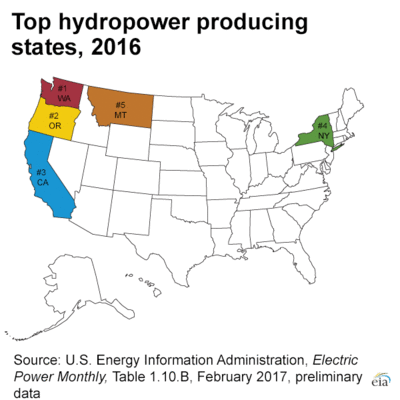Hydroelectric Power
Resources

Most of the hydropower generated in the U.S. originates in 5 states:
Technology
The hydroelectric dam, or "impoundment facility," is the most widely used water-powered technology. Typically, water from a river is impounded behind a barricade, or dam, creating a reservoir. Water is released from the reservoir as needed to flow through a turbine, causing it to spin, thus activating a generator, which produces electricity.
The "diversion facility," the second means of harnessing major water power, uses a conduit to divert, parts of a river to the turbines which set the generator in motion. Not surprisingly, the power plants at Niagara Falls, New York, are diversion facilities.
Pros and Cons
Hydropower sources rely on the flow of water to produce energy. There are several important advantages in using hydropower to generate electricity.
- Hydropower is renewable.
- It normally provides consistent, baseload power, as opposed to solar and wind, which, although renewable, provide power on an intermittant or variable basis.
- Once a hydropower plant is constructed, there are no fuel costs.
- Greenhouse gas emissions are very low under normal conditions, particularly in non-tropical regions of the world.
However, hydroelectric dams also have some disadvantages:
- Dam reservoirs cause large loss of land.
- Dams are usually located in remote areas, requiring heavy investment in transmission lines to carry power to population centers.
- There is significant damage to ecological systems, both upstream and downstream of the power plant.
- Drought can adversely affect the river flow and cause power shortages.
- In tropical regions, substantial amounts of methane, a powerful greenhouse gas, can be released, as submerged flora decay under anaerobic conditions.
- Development of a reservoir is often disruptive to the lives of people who must be relocated.
- There is the potential for failure of the dam, leading, possibly, to great loss of life.
Environment
Hydropower has important environmental benefits, but it can also have negative environmental affects as well.
Advantages of hydroelectric dams:
- Hydropower is renewable.
- Greenhouse gas emissions are very low under normal conditions, particularly in non-tropical regions of the world.
Disadvantages:
- Dam reservoirs cause large loss of land.
- There is significant damage to ecological systems, both upstream and downstream of the power plant.
- In tropical regions, substantial amounts of methane, a powerful greenhouse gas, can be released, as submerged flora decay under anaerobic conditions.